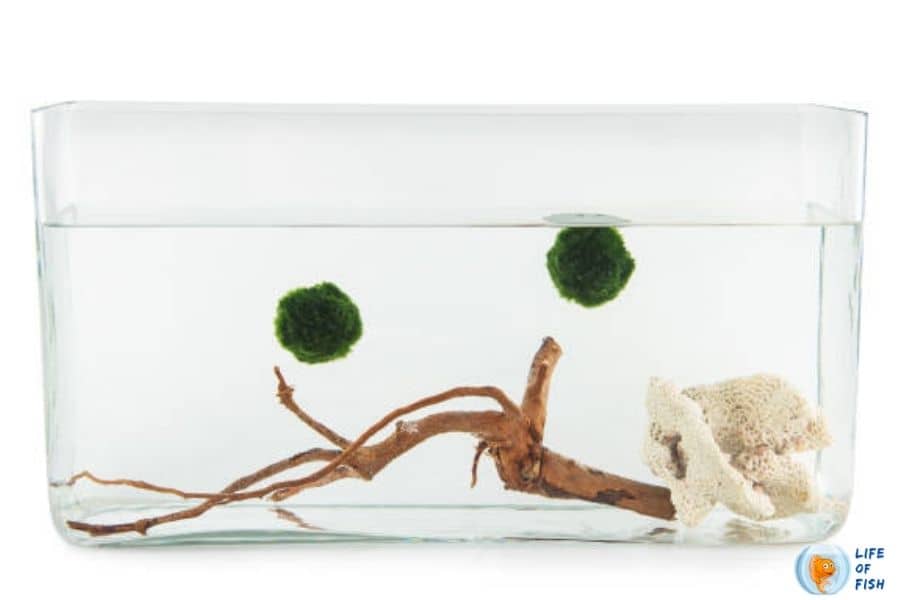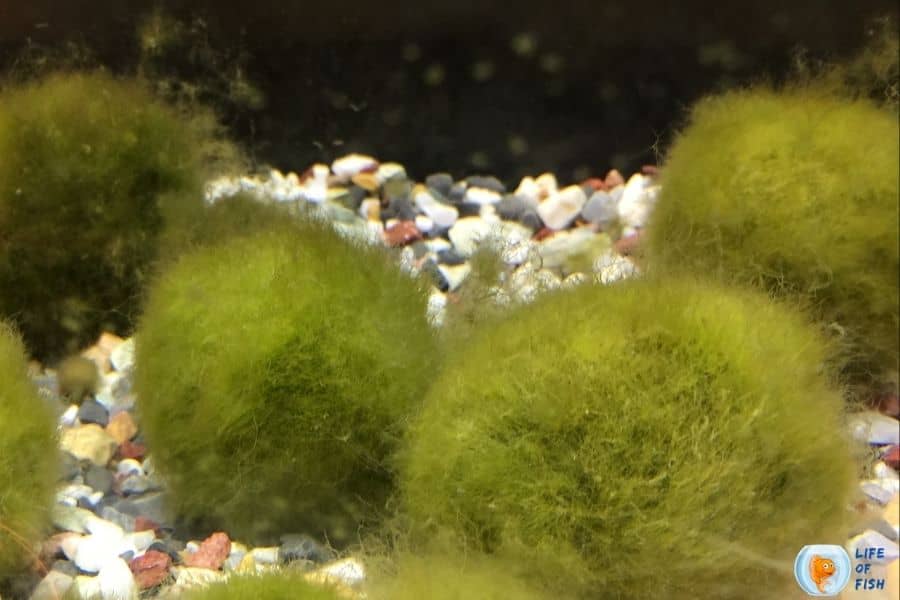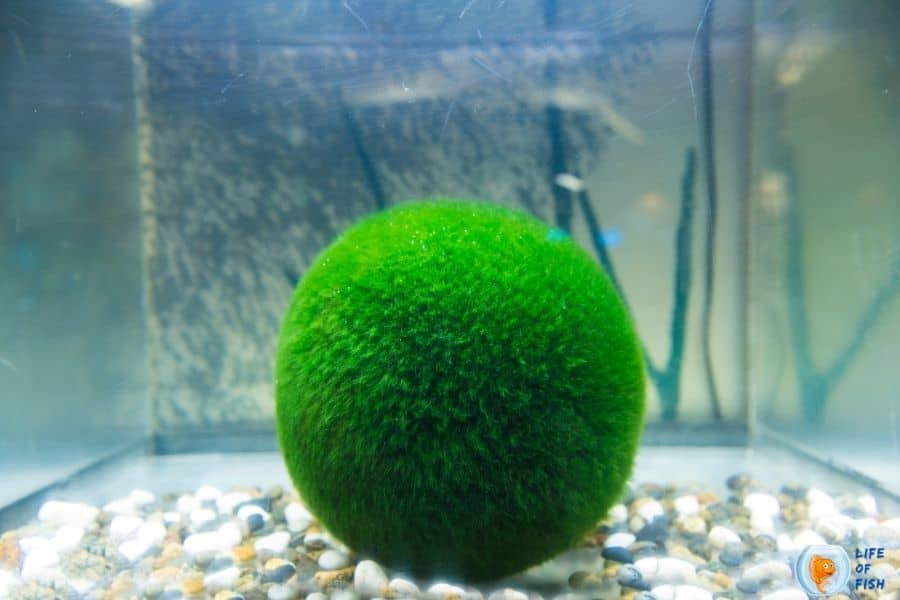Why is my Moss ball floating? This is a frequently asked question we see everywhere. Let’s find out the answers to your long waiting question.
Moss balls, commonly known as Marimo moss balls, are a bizarre but beautiful addition to any aquarium.
Aquarists love these algae not because of it’s cute appearance but because of the ease of care and the benefits they give to their aquarium.
As this is a plant, it absorbs nutrients from the water and cleans it for your fish. All it needs is a container full of water.
In Japan, these moss balls are considered Good Luck Charm. They even have a dedicated three-day festival to celebrate Marimo moss balls.
If you are new to Marimo moss balls, you will have several confusions about these moss balls. That is because these things act like they are alive like an animal. Are they? To some extent, that is why many people keep them as pets in fish tanks.

What is Moss Balls?
Jump To
- 1 What is Moss Balls?
- 2 Is it normal for moss balls to float?
- 3 Why is my moss ball floating?
- 4 Why is my moss ball not floating?
- 5 How to stop moss balls floating?
- 6 How long do moss balls live for?
- 7 Can you keep a moss ball in a jar?
- 8 When will my moss ball open?
- 9 Do moss balls clean water?
- 10 Moss Ball Facts
- 11 How much does a moss ball cost?
- 12 Conclusion
Moss ball is an alga that grows into large green balls with a velvety appearance. It is a growth form of the species Aegagropila Linnaei.
Moss balls are also known as Marimo, Cladophora ball, or Lake Ball. These species can be found in Lakes and rivers in Japan and Northern Europe, and people keep Moss Balls as pets in their fish tanks.
Usually, the size of a Moss ball will be 8 to 12 inches in the wild. However, they do not grow to their full potential in captivity.
They need a cooler temperature of about 72 to 78 F and low lighting to thrive.
Is it normal for moss balls to float?
Usually, Moss Ball Pets sink in water. But this is not the only thing they will do in your fish tank.
These things do much more than just stay on the bottom in their natural habitats. Moss balls are not attached to anything; hence they can move around while the water moves.
They usually float because of photosynthesis, carried by running water or water currents on the lake’s bottom. So, as you see, it is normal for moss balls to float.
Why is my moss ball floating?
As Moss balls perform photosynthesis, it generates oxygen bubbles.
These oxygen bubbles sometimes trap inside the ball, which helps them float up to the water surface. Sometimes a trapped air bubble may escape from the ball, making it sink.
But sometimes moss balls float due to other reasons too. One main reason is that algae inside the ball die.
As a result, the moss ball loses some of its buoyancy and loses its greenish color. If your moss ball has lost its color and floats for several days, it indicates a dead (or dying) moss ball.
Why is my moss ball not floating?
Moss balls do photosynthesis during the daytime. These oxygen bubbles often trap inside the ball, which causes the moss ball to float.
But as time passes by, these oxygen bubbles release from the ball. Then, the moss ball becomes heavier, therefore, moves back to the bottom.
When moss ball is not floating, that is not something to worry about either because it is normal. Generally, moss balls sink during the night as there is no sunlight for photosynthesis.

How to stop moss balls floating?
Mostly, Moss balls will sink to the bottom of the tank eventually after releasing the oxygen bubble and filling it with water.
But sometimes, these pets can not release the air bubble on their own, and we have to step in.
To get cleared of the air bubble, you can gently squeeze your Moss ball and roll it between your hands for a while. This will help it release the air bubble, and the Moss ball can sink to the bottom of your tank.
If you do not prefer your moss ball to float, you can attach it to anything under the water.
You can also keep it in an opaque container with a narrow opening to stop the moss ball from floating.
The other way is suspending your Moss ball directly above the bottom of your tank using a fishing line or thread.
And if you are lazy enough to do this yourself, you can buy one already attached on the fishing line online. However, all the fun of having a moss ball will lose when your moss ball does not move.
How long do moss balls live for?
If given proper care, moss balls can survive for more than 200 years.
The oldest moss ball known so far is about 95cm in diameter and 200 years old. Due to this long-living ability, they are regarded as good luck charms in Japan, and many Japanese people keep these pets as family heirlooms.
Can you keep a moss ball in a jar?
Yes. You can safely keep your moss ball in the jar, but the jar should have at least a narrow opening for the moss ball to thrive.
If it doesn’t get enough sunlight during the daytime, you can place your jar near a window sill with direct sunlight for 6 to 8 hours.
When will my moss ball open?
Your moss ball will never open if it grows healthy.
But, if you want it to open and stay like a carpet, you can cut it open and flatten them out. This will create a carpet shape in your tank, and it will never gain its spherical shape again.
Do moss balls clean water?
Yes. They do. Like any other aquatic plant, they will consume debris, ammonia, nitrates, and phosphates.
However, they may not make a difference in large tanks because of their smaller size. Still, these pets work like tiny filters in the tank’s ecosystem.

Moss Ball Facts
- Unlike its name, Marimo moss balls are not a type of moss but an algae
- Marimo moss balls are slow-growing plants. It takes around a year to grow 5mm in diameter.
- Marimo moss balls are found in the northern regions of Japan, Iceland, and Scotland.
- It is believed that Marimo moss balls can bring luck and protection from natural disasters.
- Moss ball is a popular moss variety in Japan, often kept as family heirlooms.
- Moss balls are also a popular addition to aquariums.
- Marimo moss balls have been successfully grown in space as part of experiments done by Japanese scientists.
- Marimo is a protected species in Japan, where the harvesting of Marimo moss balls is strictly forbidden.
How much does a moss ball cost?
Moss balls are pretty cheap, although they are harder to find.
You can buy about one to1 1/2 inch Marimo moss ball for around $10, while two to three inches moss ball would cost you approximately $20 or more.
Your local pet store will not readily have it. So, you will have to search for a bit to find Marimo moss balls.
Conclusion
If your moss ball is floating, usually there is nothing to be afraid of. Your moss ball is fine and does its daily routine of photosynthesis which causes it to float during the day.
When the sun sets, it will go to the bottom on its own. If not, you just have to squeeze it to release the oxygen bubbles so that it can sink again.
If your moss ball doesn’t sink for several days and changes its color, it may indicate a problem.
However, if you want your moss ball to sink and stay in a specific place in your tank, you can attach it to something heavy such as heavy rock or a big piece of driftwood that is enough for it to stay under.
But it’s interesting to see a plant move around on its own, so why stop them from having fun?
Read Next : Elatine Hydropiper | 11 Facts about Essential Nano Aquarium Plant | Ludwigia Glandulosa Ultimate Care Guide | 11 Important Facts| Hygrophila Corymbosa Care | 12 Things You Must Know |
